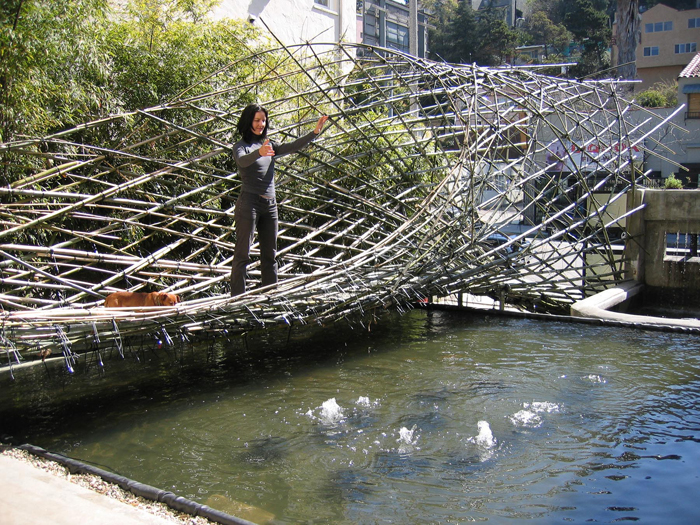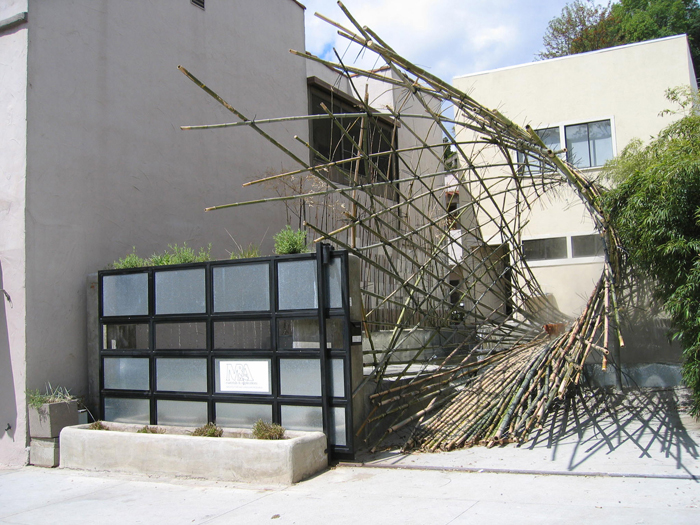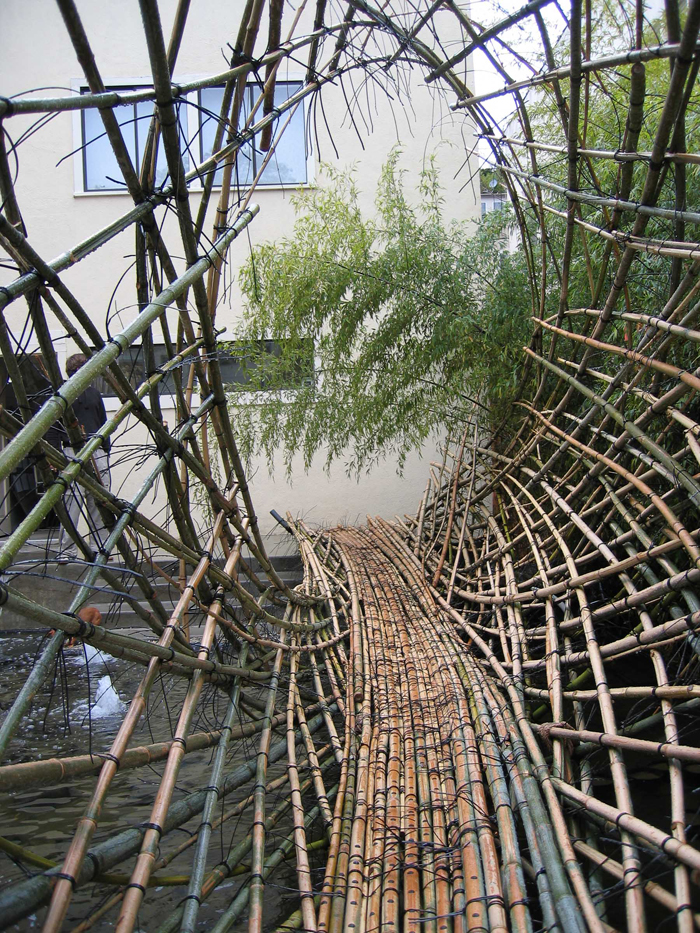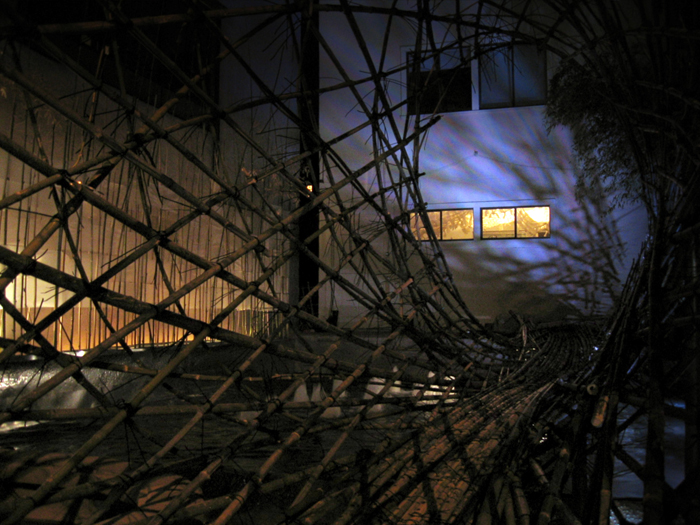
Infranatural with LEVITAS, Here There Be Monsters, installation view, dimensions variable, 2006
To enter the latest outdoor installation at Materials & Applications, one must trust one’s weight to a softly curving bamboo vortex that bows, creaks and gives as it spans a small terraced pool. This bridge glitters in dull greens and golds, shifting and resettling in constant response to its use and its environment. Its construction is apparent and simple, involving what appear to be industrial-strength twist-ties. Sheltered and cooled by tall, live bamboo, the small pool is fed by a rooftop rain catchment and is seeded with water plants. However, as the title of the work, Here There Be Monsters, warns, unknowable things lurk in this comprehensible and calm space. Hi-tech enigmas, at first shy, become bolder throughout the development of the installation, expressing themselves as gestures of watery movement in direct response to certain actions of startled visitors. They evolve and mature in response to the activity and conditions of the environment, just like the settling bridge, the rustling live bamboo, and the creeping water plants. However, the things alone remain invisible and obscure, endangering the more apparent elements of the piece, including even the visitors, with a sense of overexposure. These mysterious, elusive residents manifest anxiety within the otherwise marked comprehensibility of the installation, thereby problematizing its themes of democracy and intimacy.
Still, progressive ideals are inherent to most of the work and are not easily destabilized. For the team of Oliver Hess and Jenna Didier, Materials & Applications is a “research and exhibition center dedicated to…increase[ing] public participation in the built environment.”1 Through lecture series, screenings and hands-on workshops, the center seeks to redistribute the knowledge and ideas of architecture, design and art technocrats among the willing populace. For the Here There Be Monsters project, Didier and Hess, also known as the design team Infranatural, working with Bruce Danziger and Moritz Freund of the architectural team LEVITAS, conscripted volunteers from the community for the construction of the rainwater catchment system and the bamboo bridge structure. Inside the small Materials & Applications building, wall space is designated for descriptions of bamboo’s value as a building material, along with diagrams of lashing techniques. This egalitarian imperative confronts what philosopher Henri Lefebvre described as “forgetfulness.” For Lefebvre, industrial production is a “mystification that makes possible the fetishism of commodities: the fact that certain commodities imply certain social relationships whose misapprehension they also ensure.”2 By decentering the artist/specialist from the artwork, Here There Be Monsters challenges the existing mode of production in which division of labor isolates and standardizes the individual within a socio-economic hierarchy, while alienating him or her from the material environment.3 Here, the “eco-friendly” use of raw materials like bamboo and rainwater infuses this democratically produced work with a neo-Luddist radicalism. Ultimately, this persistent attendance to the functionality of the piece seems designed to interrogate the representational prerogative of art as cultural practice.

Infranatural with LEVITAS, Here There Be Monsters, installation details, 2006.

Infranatural with LEVITAS, Here There Be Monsters, installation details, 2006.
In positing a conflation of art and design that determines a social practice, this work is in dialogue with certain projects of Modernism, especially with the Bauhaus school. Bauhaus practitioners, working from the desire for a cohesive, encompassing aesthetic of utility, also sought to impart objects and environments with a transparent functionality. Interested in creating—rather than showing—space, they sought to articulate relationships of symbiosis including the “production of spatial ensembles…correspond[ing] to the capacity of productive forces.”4 What proceeded from their modular designs, however, was a hegemonic aesthetic manifested as the “worldwide, homogenous and monotonous architecture of the state.”5 The socio-spatial efficiency of our institutions, from the grid of the cubicle to the expansive purity of the museum wall, is testimony to this success. In totalizing art as social practice, the Bauhaus movement allowed that practice to become subsumed under this very aesthetic. In response to this industrialization of culture, Here There Be Monsters seeks to reverse the strategy. The project’s comprehensive, democratic elements in fact seek to subsume art under a totalized social practice. Furthermore, the apparent contingency and permeability of social practice here, as described through its site-specificity and lack of defined membership, assert its refusal of representation and of reproduction.
The subversion of representation in Here There Be Monsters presents an interesting problematic, however, on which hinge the work’s disparate models of reconciliatory democracy and alienating technocracy. Though the work attempts a radical refusal of representation through its subsumption of art under a totalized social practice, it still operates within art as site. Because of this dynamic, the piece becomes an interesting interrogation of site-specificity. While formally engaged with the immediate materiality of its place, the work clearly remains conceptually engaged with socio- political ideas. In this way, place is inevitably abstracted as site, and the idealized realm of art is indicted with the obstruction of potentially immediate phenomenological and communal engagement. Within this abstract space, the dangerous potential for narratives of progress still lurks.
Furthermore, as the “discussion leaders,” the artists/designers reclaim their elevated positions within a mystified practice. As a perhaps unintended consequence, the project’s “volunteers” are reduced to co-opted signifiers of community. Despite their interaction with the work, they remain ultimately as passive as the traditional art viewer. As it plays out, this uncomfortable paradox becomes a form of self-conscious rejection of the work’s status as an automatic signifier of “criticality” or “progressiveness.” As has been suggested elsewhere by art historian Miwon Kwon, “…Vanguardist, socially conscious and politically committed art practices always become domesticated by their assimilation into the dominant culture.”6

Infranatural with LEVITAS, Here There Be Monsters, installation detail, 2006.
The monsters in the pool are our evidence of this self-reflexivity. Attuned to the actions of unwary visitors, these creatures express their presence only through a watery disruption that surprises the visitor. Dwelling beneath the aquatic canopy of lily pads are what appear to be four of these instigators, each with its own territory and behavioral tendencies. Their attention is seemingly aroused by the vulnerability of visitors. As a guest first trusts her weight to the creaking bamboo trestle, she may or may not sense a gentle disturbance of the water directly below which follows her progress quietly, sending tiny ripples across the pool. As another visitor crouches at the edge of the water, observing the system of water plants, he may find himself retreating as a swell of water surges to meet him. The sudden movement of a guest in a particular corner of the pool; a swift stoop to retrieve dropped keys, or a head thrown back in laughter, might induce an agitated and rapid leap of water directed at the movement. Furthermore, in a direct articulation of the anxiety of surveillance emerging from these interactions, a visitor who turns his or her back on the scene may experience a violent crash from behind—the convulsive displacement of the entire surface of the pool—and turn to see only a rocking wake. As the visitor becomes the unwilling participant, and the viewer becomes the viewed, the omnipresent embrace of the “brave new institution,” Dave Hickey’s reincarnation of Foucault’s panopticon, is exposed.7
This unequal encounter between human and machine also presents an “other” with an ambiguous subjectivity that further destabilizes the utopian impulse towards a totalized subjectivity or social practice that is suggested throughout the piece. The question of the nature of the monsters — their authenticity, their experience, and their intelligence—challenges our very grasp of those ideas. The monsters are described by the artists as Artificial Intelligence machines, which are enabled by software to learn, choose and act in accordance with their environment. Their “awareness” evolves in the context of their “experiences,” and their actions, though systematic, are unpredictable. Despite life-like attributes, however, they appear here as vastly and ominously more unknowable than any other “other.” It can be argued that intelligence, as implemented by AI technology, has been equated with autonomy. Here as elsewhere, this is a purely “social” and “intellectual” autonomy that is in fact radically liberated from the very phenomenological basis for biological sociability and intelligence. Possibly, it is this independence from what Barbara Becker describes as an “emergent interchange of bodysubject and environment” that forestalls intimate exchange as it synopsizes the perversely limited conception of social consciousness of its designers.8
As detached and idealized as are most progressive tendencies in art, these technologies are cleanly designed systems implementing pattern processes, rather than incalculably responsive, random processes of interaction. As Here There Be Monsters warns, until it can be accepted that the idea of subjectivity is better understood as an intersubjectivity—of permeable bodies participating in a physical exchange which underlies all socio-cultural formations—the industrial, technological and institutional desire for progress may slowly close the gap between the “fetishized commodity,” the machine, the monster, and ourselves.
Elizabeth Sims is an artist and writer learning to grow her own food in Southern California.
